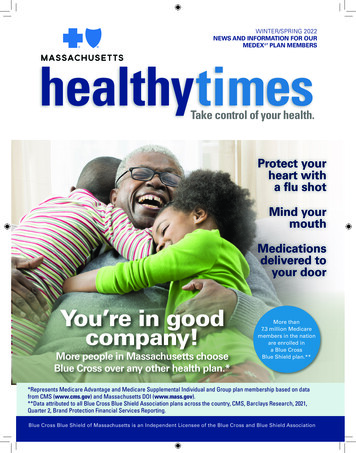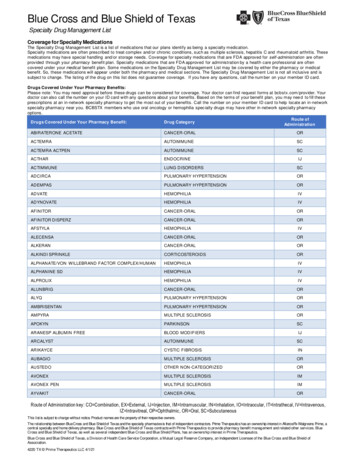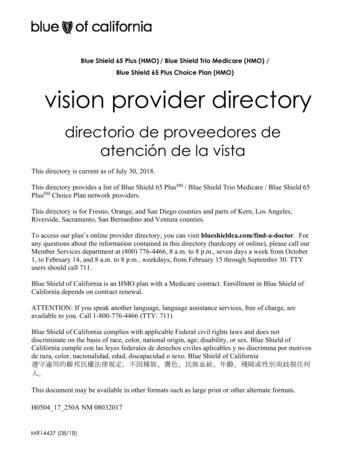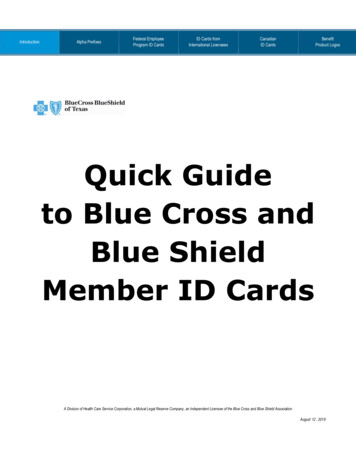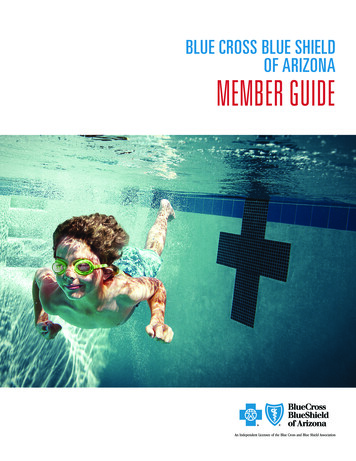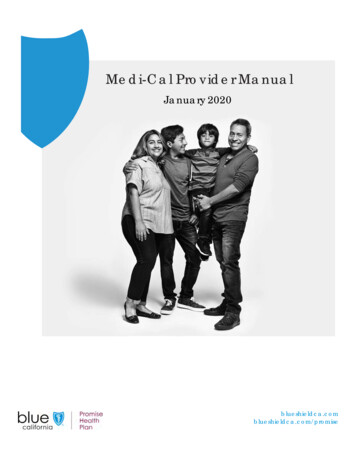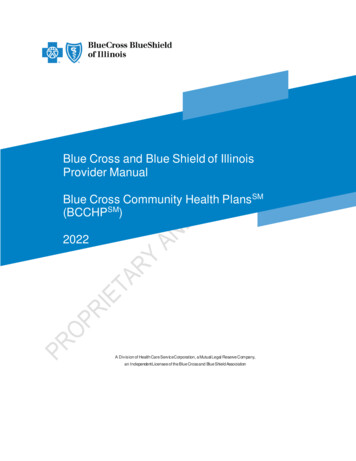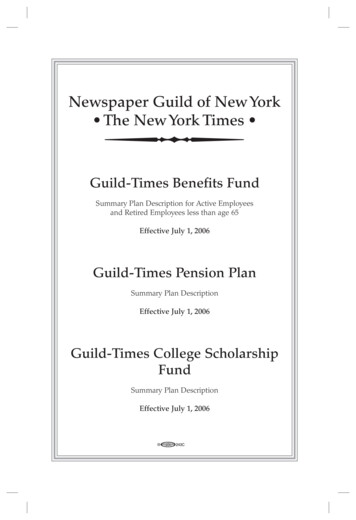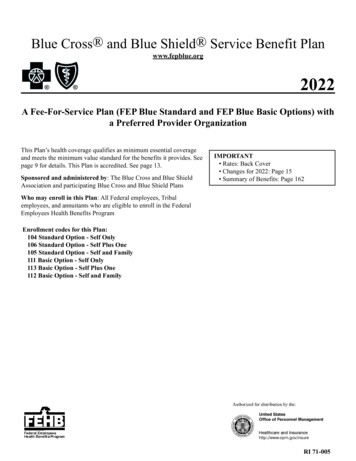
Transcription
Blue Cross and Blue Shield Service Benefit Planwww.fepblue.org2022A Fee-For-Service Plan (FEP Blue Standard and FEP Blue Basic Options) witha Preferred Provider OrganizationThis Plan’s health coverage qualifies as minimum essential coverageand meets the minimum value standard for the benefits it provides. Seepage 9 for details. This Plan is accredited. See page 13.Sponsored and administered by: The Blue Cross and Blue ShieldAssociation and participating Blue Cross and Blue Shield PlansIMPORTANT Rates: Back Cover Changes for 2022: Page 15 Summary of Benefits: Page 162Who may enroll in this Plan: All Federal employees, Tribalemployees, and annuitants who are eligible to enroll in the FederalEmployees Health Benefits ProgramEnrollment codes for this Plan:104 Standard Option - Self Only106 Standard Option - Self Plus One105 Standard Option - Self and Family111 Basic Option - Self Only113 Basic Option - Self Plus One112 Basic Option - Self and FamilyRI 71-005
Important Notice from the Blue Cross and Blue Shield Service Benefit Plan AboutOur Prescription Drug Coverage and MedicareThe Office of Personnel Management (OPM) has determined that the Blue Cross and Blue Shield Service Benefit Plan’s prescriptiondrug coverage is, on average, expected to pay out as much as the standard Medicare prescription drug coverage will pay for all planparticipants and is considered Creditable Coverage. This means you do not need to enroll in Medicare Part D and pay extra forprescription drug coverage. If you decide to enroll in Medicare Part D later, you will not have to pay a penalty for late enrollment aslong as you keep your FEHB coverage.However, if you choose to enroll in Medicare Part D, you can keep your FEHB coverage and your FEHB plan will coordinate benefitswith Medicare.Remember: If you are an annuitant and you cancel your FEHB coverage, you may not re-enroll in the FEHB Program.Please be advisedIf you lose or drop your FEHB coverage and go 63 days or longer without prescription drug coverage that is at least as good asMedicare’s prescription drug coverage, your monthly Medicare Part D premium will go up at least 1 percent per month for everymonth that you did not have that coverage. For example, if you go 19 months without Medicare Part D prescription drug coverage,your premium will always be at least 19 percent higher than what many other people pay. You will have to pay this higher premium aslong as you have Medicare prescription drug coverage. In addition, you may have to wait until the next Annual Coordinated ElectionPeriod (October 15 through December 7) to enroll in Medicare Part D.Medicare’s Low Income BenefitsFor people with limited income and resources, extra help paying for a Medicare prescription drug plan is available. Informationregarding this program is available through the Social Security Administration (SSA) online at www.socialsecurity.gov, or call theSSA at 800-772-1213, TTY: 800-325-0778.You can get more information about Medicare prescription drug plans and the coverage offered in your area from these places: Visit www.medicare.gov for personalized help. Call 800-MEDICARE 800-633-4227, TTY 877-486-2048.RI 71-005
Table of ContentsIntroduction .4Plain Language .4Stop Healthcare Fraud! .4Discrimination is Against the Law .5Preventing Medical Mistakes .6FEHB Facts .9Coverage information .9 No pre-existing condition limitation.9 Minimum essential coverage (MEC) .9 Minimum value standard .9 Where you can get information about enrolling in the FEHB Program .9 Types of coverage available for you and your family .9 Family member coverage .10 Children’s Equity Act .10 When benefits and premiums start.11 When you retire .11When you lose benefits .11 When FEHB coverage ends .11 Upon divorce .12 Temporary Continuation of Coverage (TCC) .12 Finding replacement coverage .12 Health Insurance Marketplace .12Section 1. How This Plan Works .13General features of our Standard and Basic Options .13We have a Preferred Provider Organization (PPO).13How we pay professional and facility providers .13Your rights and responsibilities .14Your medical and claims records are confidential .14Section 2. Changes for 2022 .15Changes to our Standard Option only .15Changes to our Basic Option only .15Changes to both our Standard and Basic Options .16Section 3. How You Get Care .17Identification cards .17Where you get covered care .17Balance Billing Protection .17 Covered professional providers .17 Covered facility providers .18What you must do to get covered care .20 Transitional care .20 If you are hospitalized when your enrollment begins.20You need prior Plan approval for certain services .21 Inpatient hospital admission, inpatient residential treatment center admission, or skilled nursing facilityadmission .21 Other services .22 Surgery by Non-participating providers under Standard Option .24How to request precertification for an admission or get prior approval for Other services .24 Non-urgent care claims .25 Urgent care claims .252022 Blue Cross and Blue Shield Service Benefit Plan1Table of Contents
Concurrent care claims .26 Emergency inpatient admission .26 Maternity care .26 If your facility stay needs to be extended .26 If your treatment needs to be extended .27If you disagree with our pre-service claim decision .27 To reconsider a non-urgent care claim .27 To reconsider an urgent care claim .27 To file an appeal with OPM .27 The Federal Flexible Spending Account Program – FSAFEDS .27Section 4. Your Costs for Covered Services .28Cost-share/Cost-sharing .28Copayment .28Deductible .28Coinsurance .29If your provider routinely waives your cost .29Waivers .29Differences between our allowance and the bill .29Important Notice About Surprise Billing — Know Your Rights .32Your costs for other care .32Your catastrophic protection out-of-pocket maximum for deductibles, coinsurance, and copayments .32Carryover .33If we overpay you .34When Government facilities bill us .34Section 5. Benefits .35Section 5. Standard and Basic Option Overview .37Non-FEHB Benefits Available to Plan Members .133Section 6. General Exclusions – Services, Drugs, and Supplies We Do Not Cover .134Section 7. Filing a Claim for Covered Services .136Section 8. The Disputed Claims Process.139Section 9. Coordinating Benefits With Medicare and Other Coverage .142When you have other health coverage .142 TRICARE and CHAMPVA .142 Workers’ Compensation .143 Medicaid .143When other Government agencies are responsible for your care .143When others are responsible for injuries.143When you have Federal Employees Dental and Vision Insurance Plan (FEDVIP) .144Clinical trials .144When you have Medicare .145 The Original Medicare Plan (Part A or Part B).145 Tell us about your Medicare coverage .146 Private contract with your physician .146 Medicare Advantage (Part C) .146 Medicare prescription drug coverage (Part D) .147 Medicare prescription drug coverage (Part B) .147When you are age 65 or over and do not have Medicare .149Physicians Who Opt-Out of Medicare .150When you have the Original Medicare Plan (Part A, Part B, or both) .150Section 10. Definitions of Terms We Use in This Brochure .152Index.1602022 Blue Cross and Blue Shield Service Benefit Plan2Table of Contents
Summary of Benefits for the Blue Cross and Blue Shield Service Benefit Plan Standard Option – 2022 .162Summary of Benefits for the Blue Cross and Blue Shield Service Benefit Plan Basic Option – 2022 .1642022 Rate Information for the Blue Cross and Blue Shield Service Benefit Plan.1702022 Blue Cross and Blue Shield Service Benefit Plan3Table of Contents
IntroductionThis brochure describes the benefits of the Blue Cross and Blue Shield Service Benefit Plan - FEP Blue Standard and FEP BlueBasic Options under contract (CS 1039) between the Blue Cross and Blue Shield Association and the United States Office ofPersonnel Management, as authorized by the Federal Employees Health Benefits law. This Plan is underwritten by participating BlueCross and Blue Shield Plans (Local Plans) that administer this Plan in their individual localities. For customer service assistance, visitour website, www.fepblue.org, or contact your Local Plan at the phone number appearing on the back of your ID card.The address for the Blue Cross and Blue Shield Service Benefit Plan administrative office is:Blue Cross and Blue Shield Service Benefit Plan1310 G Street NW, Suite 900Washington, DC 20005This brochure is the official statement of benefits. No verbal statement can modify or otherwise affect the benefits, limitations, andexclusions of this brochure. It is your responsibility to be informed about your healthcare benefits.If you are enrolled in this Plan, you are entitled to the benefits described in this brochure. If you are enrolled in Self Plus One or Selfand Family coverage, each eligible family member is also entitled to these benefits. You do not have a right to benefits that wereavailable before January 1, 2022, unless those benefits are also shown in this brochure.OPM negotiates benefits and rates with each plan annually. Benefit changes are effective January 1, 2022, and changes aresummarized on pages 15-16. Rates are shown on the back cover of this brochure.Plain LanguageAll FEHB brochures are written in plain language to make them easy to understand. Here are some examples: Except for necessary technical terms, we use common words. For instance, “you” means the enrollee and each covered familymember; “we” means the Blue Cross and Blue Shield Service Benefit Plan. We limit acronyms to ones you know. FEHB is the Federal Employees Health Benefits Program. OPM is the United States Officeof Personnel Management. If we use others, we tell you what they mean. Our brochure and other FEHB plans’ brochures have the same format and similar descriptions to help you compare plans.Stop Healthcare Fraud!Fraud increases the cost of healthcare for everyone and increases your Federal Employees Health Benefits Program premium.OPM’s Office of the Inspector General investigates all allegations of fraud, waste, and abuse in the FEHB Program regardless of theagency that employs you or from which you retired.Protect Yourself From Fraud – Here are some things you can do to prevent fraud: Do not give your plan identification (ID) number over the phone or to people you do not know, except for your healthcare provider,authorized health benefits plan, or OPM representative. Let only the appropriate medical professionals review your medical record or recommend services. Avoid using healthcare providers who say that an item or service is not usually covered, but they know how to bill us to get it paid. Carefully review explanations of benefits (EOBs) statements that you receive from us. Periodically review your claim history for accuracy to ensure we have not been billed for services you did not receive. Do not ask your doctor to make false entries on certificates, bills, or records in order to get us to pay for an item or service.2022 Blue Cross and Blue Shield Service Benefit Plan4Introduction/Plain Language/Advisory
If you suspect that a provider has charged you for services you did not receive, billed you twice for the same service, ormisrepresented any information, do the following:- Call the provider and ask for an explanation. There may be an error.- If the provider does not resolve the matter, call the FEP Fraud Hotline at 800-FEP-8440 (800-337-8440) and explain thesituation.- If we do not resolve the issue:CALL – THE HEALTHCARE FRAUD HOTLINE877-499-7295OR go to t-fraud-waste-or-abuse/complaint-formThe online form is the desired method of reporting fraud in order to ensure accuracy, and a quick response time.You can also write to:United States Office of Personnel ManagementOffice of the Inspector General Fraud Hotline1900 E Street NW Room 6400Washington, DC 20415-1100 Do not maintain as a family member on your policy:- Your former spouse after a divorce decree or annulment is final (even if a court order stipulates otherwise)- Your child age 26 or over (unless they were disabled and incapable of self-support prior to age 26)- A carrier may request that an enrollee verify the eligibility of any or all family members listed as covered under the enrollee’sFEHB enrollment. If you have any questions about the eligibility of a dependent, check with your personnel office if you are employed, with yourretirement office (such as OPM) if you are retired, or with the National Finance Center if you are enrolled under TemporaryContinuation of Coverage (TCC). Fraud or intentional misrepresentation of material fact is prohibited under the Plan. You can be prosecuted for fraud and youragency may take action against you. Examples of fraud include falsifying a claim to obtain FEHB benefits, trying to or obtainingservice or coverage for yourself or for someone who is not eligible for coverage, or enrolling in the Plan when you are no longereligible. If your enrollment continues after you are no longer eligible for coverage (i.e., you have separated from Federal service) andpremiums are not paid, you will be responsible for all benefits paid during the period in which premiums were not paid. You may bebilled by your provider for services received. You may be prosecuted for fraud for knowingly using health insurance benefits forwhich you have not paid premiums. It is your responsibility to know when you or a family member is no longer eligible to use yourhealth insurance coverage.Discrimination is Against the LawThe Blue Cross and Blue Shield Service Benefit Plan complies with all applicable Federal civil rights laws, including Title VII of theCivil Rights Act of 1964.We: Provide free aids and services to people with disabilities to communicate effectively with us, such as:- Qualified sign language interpreters- Written information in other formats (large print, audio, accessible electronic formats, other formats)2022 Blue Cross and Blue Shield Service Benefit Plan5Introduction/Plain Language/Advisory
Provide free language services to people whose primary language is not English, such as:- Qualified interpreters- Information written in other languagesIf you need these services, contact the Civil Rights Coordinator of your Local Plan by contacting your Local Plan at the phone numberappearing on the back of your ID card.If you believe that we have failed to provide these services or discriminated in another way on the basis of race, color, national origin,age, disability, or sex, you can file a grievance with the Civil Rights Coordinator of your Local Plan. You can file a grievance inperson or by mail, fax, or email. If you need help filing a grievance, your Local Plan’s Civil Rights Coordinator is available to helpyou.Members may file a complaint with the HHS Office of Civil Rights, OPM, or FEHB Program Carriers.You can also file a civil rights complaint with the Office of Personnel Management by mail at:Office of Personnel ManagementHealthcare and InsuranceFederal Employee Insurance OperationsAttention: Assistant Director, FEIO1900 E Street NW, Suite 3400-SWashington, D.C. 20415-3610For further information about how to file a civil rights complaint, go to www.fepblue.org/en/rights-and-responsibilities/, or call thecustomer service phone number on the back of your member ID card. For TTY, dial 711.Preventing Medical MistakesMedical mistakes continue to be a significant cause of preventable deaths within the United States. While death is the most tragicoutcome, medical mistakes cause other problems such as permanent disabilities, extended hospital stays, longer recoveries, andadditional treatments. Medical mistakes and their consequences also add significantly to the overall cost of healthcare. Hospitals andhealthcare providers are being held accountable for the quality of care and reduction in medical mistakes by their accrediting bodies.You can also improve the quality and safety of your own healthcare and that of your family members by learning more about andunderstanding your risks. Take these simple steps:1. Ask questions if you have doubts or concerns. Ask questions and make sure you understand the answers. Choose a doctor with whom you feel comfortable talking. Take a relative or friend with you to help you take notes, ask questions and understand answers.2. Keep and bring a list of all the medications you take. Bring the actual medications or give your doctor and pharmacist a list of all the medications and dosages that you take, includingnon-prescription (over-the-counter) medications and nutritional supplements. Tell your doctor and pharmacist about any drug, food, and other allergies you have, such as to latex. Ask about any risks or side effects of the medication and what to avoid while taking it. Be sure to write down what your doctor orpharmacist says. Make sure your medication is what the doctor ordered. Ask the pharmacist about your medication if it looks different than youexpected. Read the label and patient package insert when you get yo
This Plan's health coverage qualifies as minimum essential coverage and meets the minimum value standard for the benefits it provides. See page 9 for details. This Plan is accredited. See page 13. Sponsored and administered by: The Blue Cross and Blue Shield Association and participating Blue Cross and Blue Shield Plans
